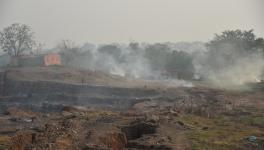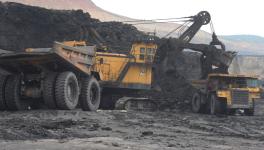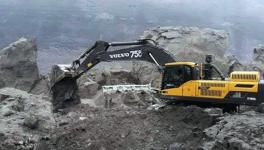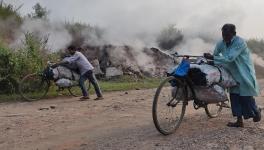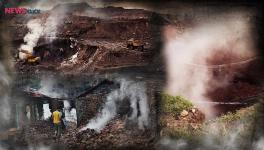How Coal Mining in Jharia is Causing Human and Environmental Disaster
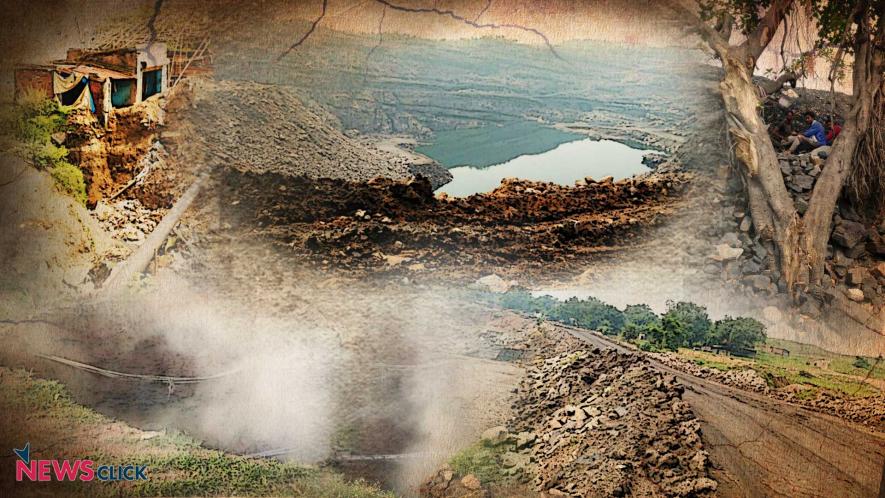
Newsclick Image by Nitesh Kumar
The flames of underground fires that have been burning in Jharia – India’s largest coalfield that produces high quality fossil fuel – have been brought up to the surface because of the open-cast mining that began in recent decades, posing a serious and devastating threats to the local population.
As communities are destroyed and thousands suffer from toxic fumes, what lies behind this human and environmental disaster?
The idea behind the open-cast mining was – explains Jharia Coalfield Bachao Samiti President Ashok Agarwal – to dig out coal in less time and at low cost. “But underground mining was already done here. Many unproductive mines were just abandoned without shutting them down properly. There were a lot of tunnels made by earlier miners to extract coal. These tunnels had left over pieces of coal. When the open-cast mining was started at the places where underground mining has already been done, the faces of the tunnels were opened up. As a result, the left over coals began catching fire because of its exposure to the oxygen, low ignition temperature and other sources of combustion. As these were often far underground they were difficult to suppress and were left to smoulder in the hope they might burn out,” he told Newsclick.
Jharia is the only mine in India where coking coal, which is highly inflammable, is found. There is coal everywhere. “In professional mining, safety equipment are used and safety procedures are followed. But illegal miners enter mines filled with inflammable gases with candles or a fire lantern that cause fire and further worsen the situation,” said a mining engineer who has lived in the area for years.
The consequences are catastrophic. The fires are causing widespread environmental and health problems. It has contaminated the air, water and soil in the region. Trees and vegetation are dying in most places of this arid dystopian landscape.
“Because of the poisonous gases such as carbon monoxide, arsenic and sulfur dioxide released into the air with smoke that the ground keeps emiting, there are high number of cases of tuberculosis, asbestosis (an occupational lung disease and a restrictive lung disease caused by the inhalation of dust) and wheezing (high-pitched whistling sound made while breathing) in and around Jharia. Patients complaining of rashes and skin allergies also often come to us,” Dr Masoom Alam, a physician at a local hospital, told Newsclick.
In open-cast mining, explosions are done using dynamite and gunpowder to dig a hole in the ground to extract coal. “This leads the dust and toxins to spread widely. It severely impacts the health of people living in the area. Despite health hazards, there is no preventive facility to protect people who help the government generate revenue by coal here. There has to be some kind of special initiative to safeguard their health,” he said.
Jharia coal mine is spread across an area of 450 square kilometres with nearly 5 lakh lives depending on the region. Fire continues to devour beneath the earth at 67 different areas. In many places, coal continues to burn at temperatures up to 700 degrees Celsius, a few metres below the earth’s surface, defying all human efforts to extinguish it.
“The fire is spreading. We do not know the length and breadth of the fire. Jharia will soon find a mention in history books. It is destined to die. The way the BCCL is going on, they want to double the production by 2020. In that case more and more mining will be done here and many more villages will have to be shifted. So the place will vanish one day. It is only a matter of time,” said Agarwal.
Get the latest reports & analysis with people's perspective on Protests, movements & deep analytical videos, discussions of the current affairs in your Telegram app. Subscribe to NewsClick's Telegram channel & get Real-Time updates on stories, as they get published on our website.









